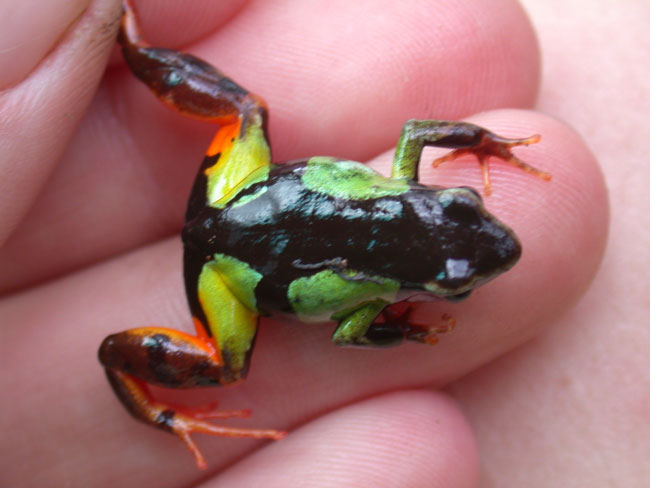Convergent Evolution in Poison Frogs

Scientists have discovered one of the most intricate examples of convergent evolution with the help of South American "poison" frogs and ants and their cousins in Madagascar. (And here's an odd fact for smokers: one Madagascan frog studied was found to have nicotine in its system!)
Poison frogs can't make their own poison--they steal it from ants. Poison frogs secrete a variety of chemicals called alkaloids to create a poisonous defense against predators. Since they can't produce alkaloids on their own, these frogs maintain a steady diet of specific alkaloid-rich ants to keep up their defense.
Now, Valerie Clark of Cornell University and her colleagues have detailed two instances of convergent evolution--the process in which organisms not closely related independently acquire similar characteristics while evolving in separate ecosystems--between frogs and ants on two continents.
First, species of ants high in alkaloids had to evolve on two separate continents.
"The ants had to be there with alkaloids for the frogs to evolve to get alkaloids in their skin," Clark told LiveScience.
Then the frogs had to develop a resistance to the alkaloids--instead of spitting out the ants or passing the alkaloids through their systems, the frogs became able to keep their ant dinners down. Then they evolved to make use of the alkaloids themselves.
Also, both the frogs in South America and Madagascar evolved to have "don't-eat-me" skin colorings, the final step in a remarkable tale of multi-step convergent evolution.
Sign up for the Live Science daily newsletter now
Get the world’s most fascinating discoveries delivered straight to your inbox.
Up until now, scientists have mainly studied frogs from South America and Australia. But Clark and her colleagues showed that the Madagascan frogs needed the same types of food to be poisonous.
They examined the stomach contents of 21 frogs from the genus Mantella and found that alkaloid rich ants made up 67 percent of their food intake.
Not only that, but they found nicotine--the same chemical found in cigarettes--in one Mantella baroni frog out of 22 examined. Nicotine is produced by plants and can sometimes be found in animals that eat these plants. But so far no nicotine-producing plants have been found growing in the area where this frog was found. This was the first time researchers observed this phenomena and they are not sure how the chemical enters the frog's system.
"Our team has not yet conducted a survey of possible nicotine containing in the area where the nicotine-frog was found, and none of our team's insect samples yielded nicotine in chemical analyses," Clark said. "However, this is some of the most convincing evidence that plant-insect-frog toxin food chains do exist."
Other characteristics the Madagascan frogs share with their South American cousins include terrestrial eggs, small body size, and toothless jaws.
Scientists have long known that frogs rely on a diet of ants, beetles, and millipedes to produce their poison. When poison frogs are captured and kept in captivity, they retain skin alkaloids for years.
But they can't make more without eating the right types of ants. Frogs kept in captivity and fed a steady diet of flies, for example, don't secrete alkaloids.
This research is detailed in an upcoming issue of the journal Proceedings of the National Academy of Sciences.
Related Stories
- Oops! Dinosaur Teeth Sales are a Croc
- Shrieking Frogs Unnerve Hawaiian Island
- Frogs Hatch Earlier to Escape Snacking Snakes










